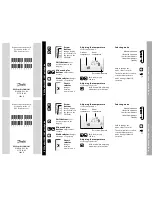
Yokogawa Electric Corporation - TC10 - ENGINEERING MANUAL - PAG. 19
[121] uSrb -
button function during RUN TIME
Available:
Always.
Range:
nonE = No function;
tunE = Auto-tune/self-tune enabling. A single
press (longer than 1) starts the auto-tune;
oPLo = Manual mode. The first pressure puts the
instrument in manual mode (OPLO) while a
second one puts the instrument in Auto mode;
AAc = Alarm reset;
ASi =
Alarm acknowledge;
chSP = Sequential set point selection (note);
St.by = Stand by mode. The first press puts the in-
strument in stand by mode while a second
one puts the instrument in Auto mode;
Str.t = Reserved;
P.run = Reserved;
P.rES = Reserved;
P.r.H.r = Reserved.
Notes: 1.
When “
Sequential set point selection
” is used,
every press of the
button (longer than 1
second) increase the value of A.SP (active set
point) of one step.
The selection is cyclic: SP -> SP2 -> SP3 -> SP4
When a new set point is selected using the
key, the display will show for 2 seconds the
acronym of the new set point (e.g. SP2).
2.
When “
Sequential set point selection
” is used, the
number of set points selectable is limited by [74] nSP.
[122] diSP - Display management
Available:
Always.
Range:
nonE = Standard display;
Pou = Power output;
SPF = Final set point;
SPo = Operative set point;
AL1 = Alarm 1 threshold;
AL2 = Alarm 2 threshold;
AL3 = Alarm 3 threshold;;
Pr.tu = Reserved;
Pr.td = Reserved;
P.t.tu = Reserved;
P.t.td = Reserved;
ti.uP = Reserved;
ti.du = Reserved;
PErc = Percent of the power output used during soft
start (when the soft start time is equal to
infinite, the limit is ever active and it can be
used also when ON/OFF control is selected);
PoS = Reserved.
[123] di.CL - Display colour
Available:
Always.
Range:
0 =
The display colour is used to show the
actual deviation (PV - SP);
1 =
Display red (fix);
2 =
Display green (fix);
3 =
Display orange (fix).
[124] AdE - Deviation for display colour management
Available:
When [123] di.CL = 0.
Range:
1 to 9999 engineering units.
[125] diS.t - Display time out
Available:
Always.
Range:
oFF = The display is ever ON;
0.1 to 99.59 minutes and seconds.
Note:
This function allows to turn OFF the display when no
alarm is present and no action is made on the instrument.
When diS.t is different from OFF and no button is
pressed for more than the programmed time out, the
display goes OFF and only 4 segments of the less
significant digit are turned ON in sequence in order to
show that the instrument is working correctly.
If an alarm occures or a buton is pressed, the display
will come back to the normal operation.
[126] FiLd - Filter on the displayed value
Available:
Always.
Range:
oFF = Filter disabled;
From 0.0 (oFF) to 20.0 engineering units.
Note:
This is a “window filter” related to the set point; it is
applied to the displayed value only and it have no
effect on the other functions of the instrument (control,
alarms, etc.).
[128] dSPu - Status of the instrument at power up
Available:
Always.
Range:
AS.Pr = Starts in the same way it was prior to the
power down;
Auto = Starts in Auto mode;
oP.0 = Starts in manual mode with a power output
equal to zero.
St.bY = Starts in stand-by mode
Notes: 1.
When you change the value of [129] oPr.E, the
instrument forces [130] oPEr parameter to Auto.
2.
If the “[128] dSPu” parameter is different from
“AS.Pr” the memorization function is inhibited.
[129] oPr.E - Operative modes enabling
Available:
Always.
Range:
ALL = All modes will be selectable by the next
parameter;
Au.oP = Auto and manual (OPLO) mode only will be
selectable by the next parameter;
Au.Sb = Auto and Stand-by modes only will be se-
lectable by the next parameter.
Note:
When you change the value of [129] oPr.E, the
instrument forces [130] oPEr parameter equal to Auto.
[130] oPEr - Operative mode selection
Available:
Always.
Range: •
When [129] oPr.E = ALL:
Auto = Auto mode;
oPLo = Manual mode;
St.bY = Stand by mod.e
• When [129] oPr.E = Au.oP:
Auto = Auto mode;
oPLo = Manual mode.
• When [129] oPr.E = Au.Sb:
Auto = Auto mode;
St.bY = Stand by mode.
]
Ser group - Serial link parameter
[131] Add - Instrument address
Available:
Always.
Range:
oFF = Serial interface not used;
1 to 254.
















































